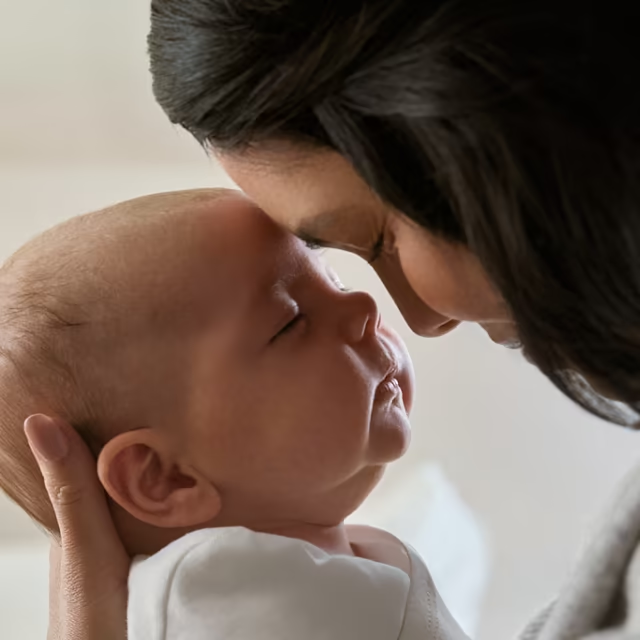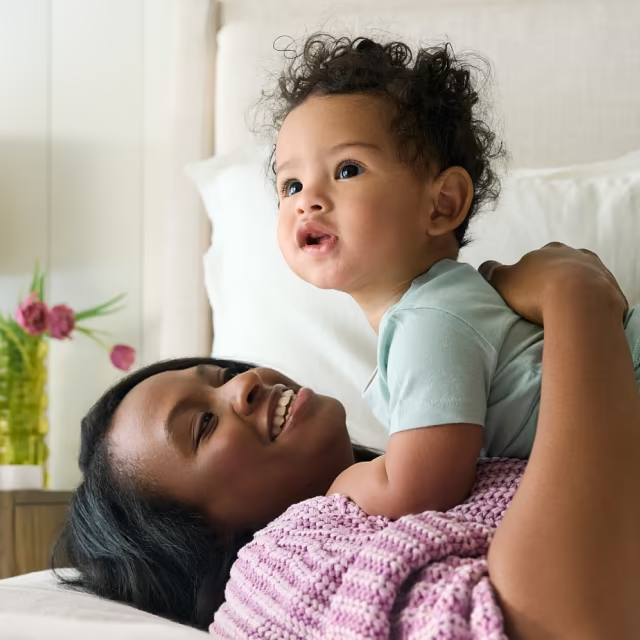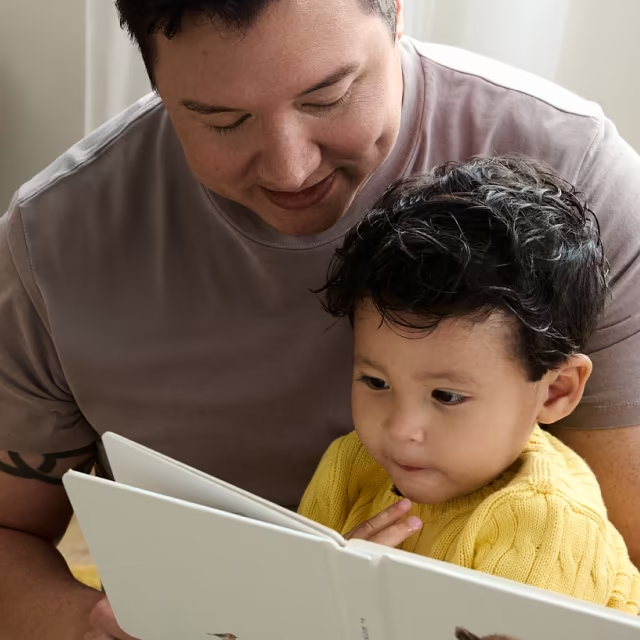Whether you're exclusively bottle feeding or using bottles occasionally, choosing the best baby bottle can be overwhelming. I’ll cover everything you need to know about how to choose a bottle, how to prepare a baby bottle, how to clean your baby’s bottles, and even how long bottles can be left out.
If you need help with introducing the bottle, be sure to check out my blog, Bottle Feeding 101: Essential Techniques and Tips.
How do I choose the best bottle for my baby?anchor
Before shopping for baby bottles, it can be helpful to know what sets different bottles apart. Some common bottle features to consider are:
Bottle material - Bottles are most commonly made of plastic, glass, or silicone.
Ease of cleaning - The number of bottle components and whether it’s dishwasher safe are both things to consider when it comes to ease of cleaning.
Breast pump compatibility - Some bottles are designed to connect with a specific breast pump, so you can pump right into the bottle. (Note: Many bottles also have an attachment option to allow for this.)
Designed specifically to reduce air intake - Some bottles have built-in vents or valves to reduce air intake during feedings, which can help reduce gas or spit-up.
Mimic the breast - Some bottles and nipples are designed to mimic the breast, making it easier to go back and forth between breast and bottle feeding.
Special note for nursing babies: If your little one is transitioning from breast to bottle or you plan to nurse and bottle feed, know that a gradually sloping nipple can be helpful. To check for a gradual slope: Make a triangle with your fingers, and if the bottle nipple takes up most of the triangle, it’s a good choice. If there’s a lot of space around the nipple when your fingers are in a triangle, it’s probably not ideal.
Here is an example:
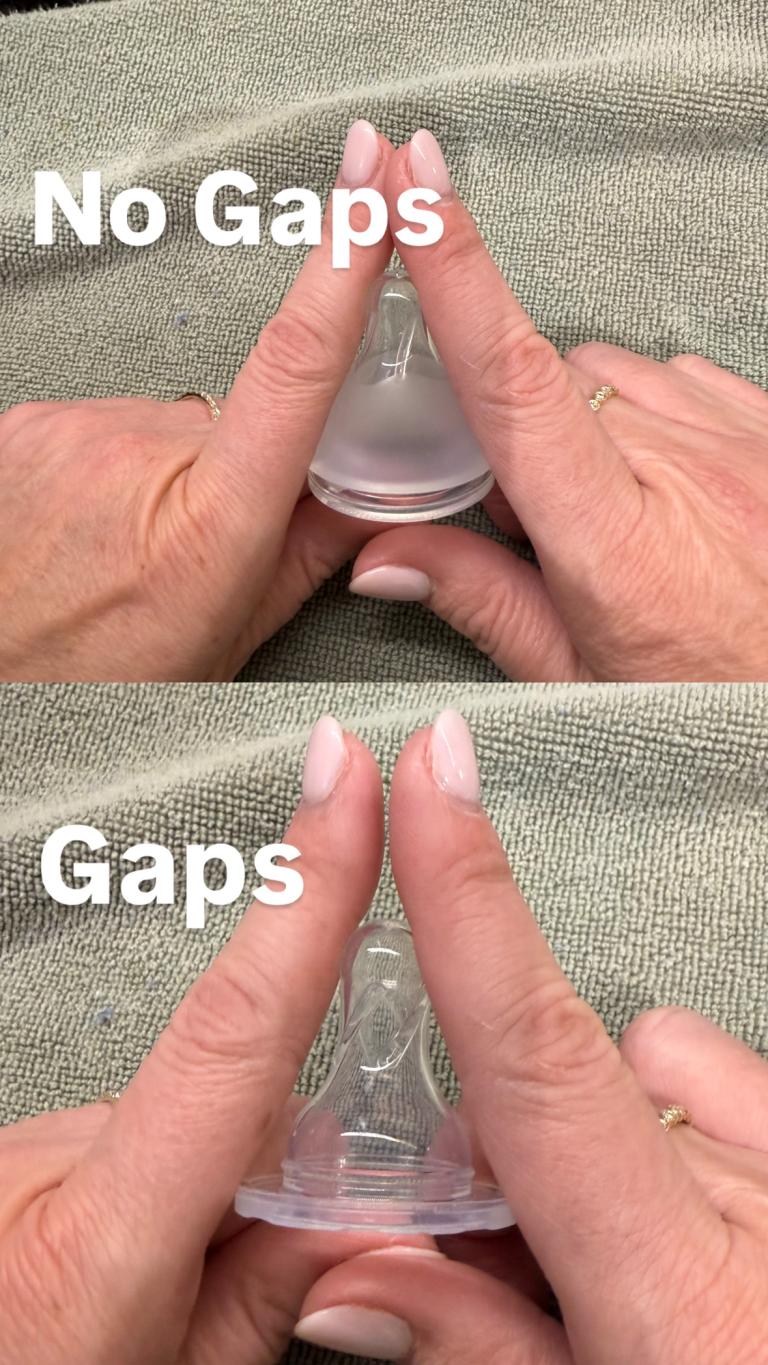
What are the best baby bottles?anchor
After researching and consulting with my team, I’ve put together a list of the best bottles to try for your little one:
Best bottles for a newborn baby
Phillips Avent Natural Response
Nanobebe Flexy Silicone
MAM Easy Start Anti-Colic
For a breastfed baby
Lansinoh Anti-Colic Baby Bottles for Breastfeeding Babies
Nuk Perfect Match
Evenflo Feeding Premium Proflo Venting Balance Plus Wide Neck
For a gassy baby
Dr. Brown’s Anti-Colic
Lansinoh Anti-Colic Baby Bottles
Best value
Nuk Smooth Flow Anti Colic
Tommee Tippee Closer to Nature
Best glass bottle
Dr. Brown's Natural Flow Anti-Colic Narrow Glass Baby Bottle
Phillips Avent Glass Natural Baby Bottle with Natural Response Nipple
Bibs Baby Glass Bottles
You can find all of our favorites here.
Choosing the best bottle for your baby can take some trial and error. Some babies are picky about which bottles and nipples they want to accept. Consider purchasing a few different types or brands of bottles so that you can experiment and find the right fit for your baby. One great option is to try something like this Babylist Bottle Box that allows you to try different brands without committing to an entire set.
How do I prepare a bottle?anchor
Let me walk you through how to prepare a bottle from powdered infant formula, concentrated or ready-to-feed liquid formula.
How to safely prepare formula: anchor
The exact steps for preparing a bottle will vary based on your formula. Please follow the manufacturer's directions on your formula for the most precise instructions and ratios for making your baby’s bottle.
Here are things to keep in mind:
Always start with clean hands, clean supplies, and a clean surface.
Before using a container of formula, check the expiration date and that the container is in good condition (no dents, rust, etc.). Write the date on your container to note when you opened it. Keep in mind that most formula needs to be used within one month of opening, but check your manufacturer's recommendations.
If the formula requires mixing: (only powdered or concentrated formula)
Follow the manufacturer’s ratio and instructions on your formula. Carefully measure out the appropriate amount of water and formula per the instructions on the container of formula.
Always pour the water into the bottle first and then the formula.
Powdered or concentrated infant formula should be mixed with warm or room temperature water. Cold water may not allow the formula to dissolve completely, while hot water can actually damage some of the nutrients in the formula.
Do not add any water to ready-to-feed formulas.
Before offering a warm bottle to your baby, test the temperature by shaking a few drops onto your wrist. The temperature should hardly be noticeable.
You can prepare formula for the day by preparing the formula in a pitcher or in individual bottles. Keep in mind that prepared formula needs to be stored in the fridge and is good (if it has not yet been offered to your baby) for 24 hours. Continue to follow all manufacturer guidelines when measuring water and formula.
If you want more help, the Centers for Disease Control provides in-depth instructions for proper bottle preparation.
Safety Note: When mixing formula with water, know that for babies under 2 months or with a weakened immune system, the AAP recommends using tap water that has been brought to a rolling boil for at least one minute and then cooled. For babies over 2 months, clean tap water is a safe option. The AAP also recommends calling your local health department to ask about your tap water before using it in bottles.(7, 11)
How to warm a baby bottleanchor
The steps for warming your baby’s bottle depends on whether it contains formula or breast milk.
How to warm a bottle of formula:anchor
Many babies take a bottle with room temperature formula (and some even enjoy a bottle from the fridge). This is perfectly fine if your little one is happy with the temperature. If your little one does prefer their bottle warm, let's walk through two options to do this safely.
Warm water. Simply place the prepared and closed bottle into a bowl or large cup of warm water for a few minutes. You can even opt to place the prepared bottle under a faucet of running water.
Bottle warmer. Some families like the convenience of using an electric bottle warmer that is specifically designed for baby bottles. Please be aware that the bottle warmer itself does get very hot and should always be out of reach of little ones.
Safety Note: Avoid using the microwave to warm up a bottle. Using a microwave creates hot spots in the bottle, which could be dangerous.
After you’ve warmed up your baby’s bottle, always make sure you test the temperature before giving it to your baby. You can do this by tapping a few drops of milk onto the inside part of your wrist. You should barely be able to feel it. If the milk feels uncomfortably warm or hot to you, then allow it to cool and reassess before offering the bottle to your baby.
How to warm a bottle of breast milk:anchor
Nursing babies often prefer milk at body temperature. ( About 98.6°F or 37°C). The safest and most effective way to warm breast milk is by placing a sealed container (bottle or bag) in a bowl of warm water or under warm, but not hot, running water.(16)
Important notes for warming bottles of breast milk:
If you place frozen breast milk in the refrigerator to thaw, it should be used or discarded after 24 hours from when it is fully thawed.
Once breast milk is warmed or brought to room temperature, it needs to be used or discarded within 2 hours.
Do not thaw or warm up breast milk in the microwave, as this can alter the nutrient content or cause uneven temperatures that could be unsafe.
Always test the temperature before offering the bottle by dropping a bit on your wrist. You shouldn’t even notice the temperature — not too cool, not too warm.
For more in-depth instructions on how to properly and safely store and prepare breast milk, please refer to the CDC’s recommendations.
How long can a bottle be left out? anchor
The answer depends on where the bottle is being stored, if it’s already been offered to your baby, and what’s in the bottle. Let me explain.
Bottles of formula:
If your baby has not been offered the prepared bottle, it can stay out for 2 hours from the time of preparation. If the bottle has been out for more than 2 hours, it’s time to dump it.
If your baby has been offered the bottle and doesn’t finish it, the bottle could stay out for one hour before you need to dispose of the rest of the contents.
If the formula has been prepared and then placed in the fridge (but has not been offered to your baby), the prepared formula can stay fresh for up to 24 hours.
It’s important to discard the formula or bottle after the recommended amount of time because the formula and bottle can grow bacteria that aren’t safe for your baby. I know it can be hard to keep track of the times of bottle preparation, so when in doubt, toss it out!
Bottles of breast milk:
If you have freshly pumped and collected breast milk that has not been offered to your baby, it can stay at room temperature for 4 hours before it must be discarded or placed in the fridge/freezer.
If your bottle contains breast milk that has been removed from the fridge/freezer (and thawed, warmed, or previously cooled), the bottle can stay out for 2 hours before discarding.
If your baby has been offered the bottle and doesn’t finish it, the bottle could stay out for two hours before you need to dispose of the rest of the contents.
It’s important to discard breast milk after it has been sitting out for a certain amount of time because it can grow bacteria that wouldn’t be safe for your baby. I know it can be hard to keep track of the times of bottle preparation, so when in doubt, toss it out!
Should I sterilize my bottles?anchor
The AAP recommends sterilizing bottles and nipples before using them for the first time. After that, the AAP says that it’s fine to wash the bottles in hot, soapy water after each use. (You can sterilize your bottles in between uses, but it’s not required.)(12)
Expert Tip: When washing bottles and nipples, use a separate bowl in the sink. This prevents sink germs from getting into your baby's feeding items.
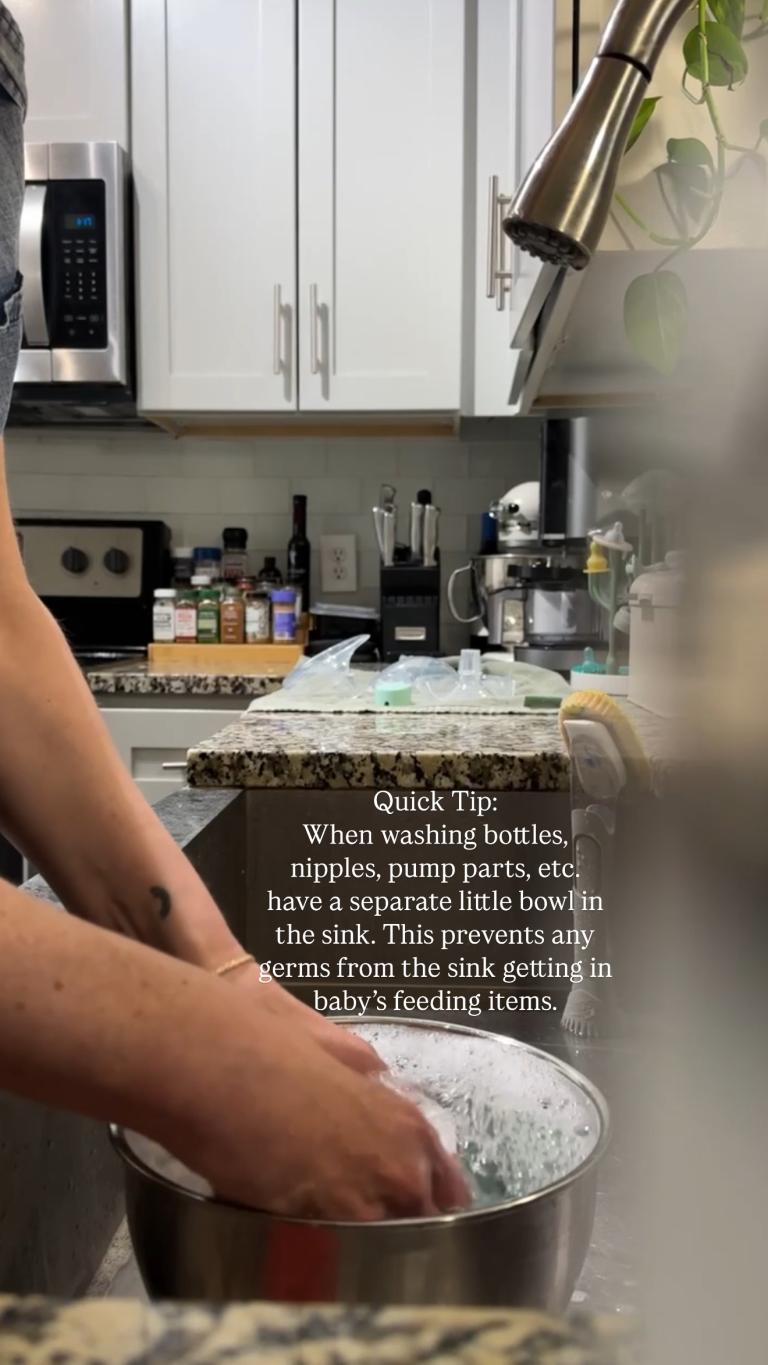
Bottle Feeding Preparation FAQ:anchor
-
Bottles typically come in 4 and 8-ounce sizes. Choosing which size is truly a matter of preference. All bottle-fed babies will eventually need the 8-ounce size.
Bottle nipples come in various sizes/flow rates, ranging from “slow flow” to “fast.” Newborns often do well with a slow flow nipple, but as they get older, they need an increased size/flow rate. Most bottle brands offer a chart to help decide which size nipple is most appropriate for the age of your baby. Start with that recommendation and then see how your baby responds. Watch for signs that the flow is too quick or too slow. If the flow is too quick, you might see your baby gulping, coughing, milk spilling from their mouth, or them unlatching and turning their head. If the flow is too slow, you might notice fussiness, irritation, or even that the nipple collapses as your baby tries to feed.
-
Please refer to your specific bottle brand manufacturer for their recommendation on when to replace the bottles. In general, this is about every 3-6 months. Bottle nipples should be replaced immediately if you notice any tears in the nipple.
-
It is possible to wash many baby bottles in the dishwasher, but always check the manufacturer’s directions. If you opt to use the dishwasher for your baby bottles, here are a few tips:
- Make sure you have completely disassembled the bottle pieces.
- Use the “hot” or sanitizing option on your dishwasher to help kill germs.
- Use the top rack of the dishwasher to avoid melting any plastic pieces.
References
16 Sources
Fu et al. (2021). Type of Milk Feeding and Introduction to Complementary Foods in Relation to Infant Sleep: A Systematic Review
Brown, A. & Harries, V. (2015). Infant sleep and night feeding patterns during later infancy: association with breastfeeding frequency, daytime complementary food intake, and infant weight.
Healthy Children, AAP. (2023). From Bottle to Cup: Helping Your Child Make a Healthy Transition
CDC. (2023). Infant Formula Preparation and Storage
CDC. (2023). Breast Milk Storage and Preparation
CDC. (2023). Human milk storage information.
American Academy of Pediatrics. (2023). How to Prepare and Store Infant Formula.
FDA. (2025). Infant Formula.
Healthy Children, American Academy of Pediatrics. (2022). Amount and Schedule of Baby Formula Feedings
Healthy Children, American Academy of Pediatrics. (2018). How much formula does my baby need?
Healthy Children, American Academy of Pediatrics. (2024). How to Safely Prepare Baby Formula with Water.
Healthy Children, American Academy of Pediatrics. (2024). Formula Feeding FAQs: Preparation and Storage.
Healthy Children, American Academy of Pediatrics. (2022). Forms of Baby Formula: Powder, Concentrate & Ready-to-Feed.
Healthy Children, American Academy of Pediatrics. (2023). Choosing a Baby Formula.
Healthy Children, American Academy of Pediatrics. (2023). How to Sterilize and Warm Baby Bottles Safely.
CDC. (2024). Storage and Preparation of Breast Milk
Keep in mind that the information and content on this blog is for informational purposes and should not be considered medical advice. If you have questions about your child, please reach out to your doctor.


